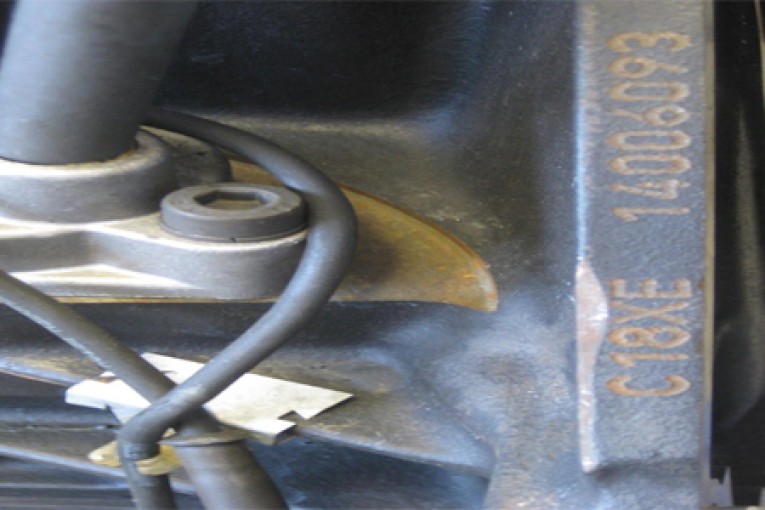
The 1.8i 16V C 18 XE engine – with varying engine displacement – is installed in a large number of Vauxhall models. In changing the timing belt, however, serious mistakes are often made when the tension pulley is adjusted.
To ensure that changing the belts goes smoothly, ContiTech Power Transmission Group is using this month’s column to provide you with detailed, step-by-step installation tips in order for you to replace the belts correctly.
When the timing belts are changed, the tension pulley, the guide pulley and the water pump should be replaced as well. Vauxhall recommends replacement after 60,000 km or every four years. When carrying out a replacement, mechanics need a tool to lock the camshaft, for instance the Multilock from the CONTI® TOOL BOX. On an Astra F, it takes about one hour to replace the parts.
Preparatory work
Identify the vehicle using the engine code, which can be found on the outer edge of the transmission mounting flange on the engine block (Fig 1 below).
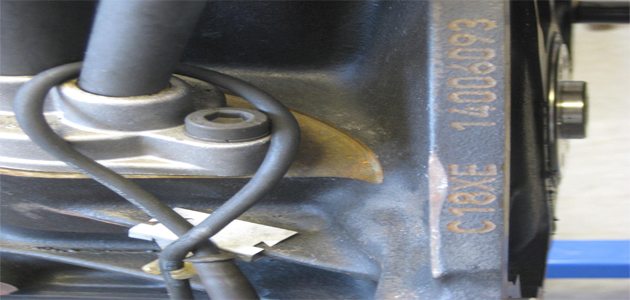
(Fig 1)
Disconnect the vehicle’s battery. Next, dismount the air filter, the air intake hose and, on engines with the code C 18 XE/XEL, also the air mass sensor. Support the engine and remove the right engine mount, the auxiliaries and the V-ribbed belt. Then dismount the power steering pump and the air-conditioning compressor and remove the timing belt cover.
Disassembling the timing belt
Turn the crankshaft to the right until the control mark on the crankshaft pulley aligns with the tip on the engine block (Fig 2 below).
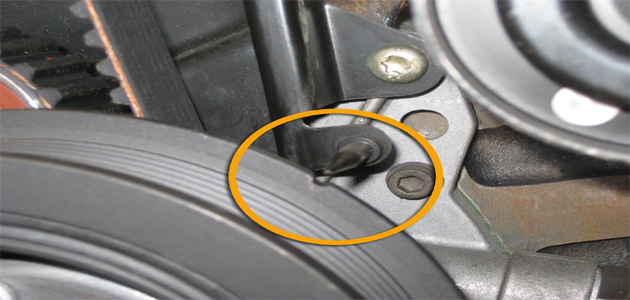
(Fig 2)
On camshaft pulleys with a single control mark, make sure that the mark of the respective camshaft pulley is aligned with the marks of the valve cover. On camshaft pulleys with two control marks, check that the “INTAKE” and “EXHAUST” control marks are aligned with the marks of the valve cover (Fig 3 below).

(Fig 3)
Lock the camshaft with the locking tool (Fig 4 below).
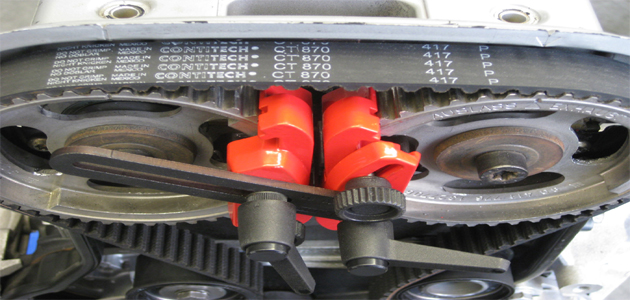
(Fig 4)
Note: If the timing belt is removed without locking the camshafts, the camshafts turn, the engine timing is off and the timing belt can no longer be mounted properly. In such cases, the camshafts can only be put in a position for mounting by using inappropriate methods.
Remove the crankshaft screw and loosen the tension pulley screw. Turn the tension pulley to the right until the pointer is at the left stop. Here, the tab attached with a hexagon socket screw must move clockwise downwards; use a hexagon socket wrench to do this. You can now remove the timing belt. Drain the cooling water and dismount the tension and idler pulleys and the water pump.
Installation of the timing belt
Replace the idler pulleys and water pump.
Note: When installing the water pump, make sure that it is positioned correctly. The nose of the water pump must be placed in the recess of the rear timing belt housing (Fig 5 below).
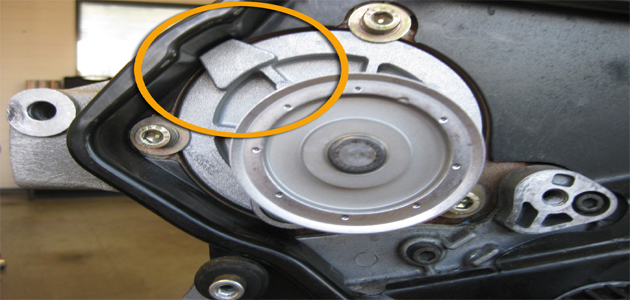
(Fig 5)
Now install the new tension pulley. Make certain that the counter support on the back of the tension pulley (base plate of the tension pulley) is positioned between the contact surfaces on the engine block and not next to them (Fig 6 below).
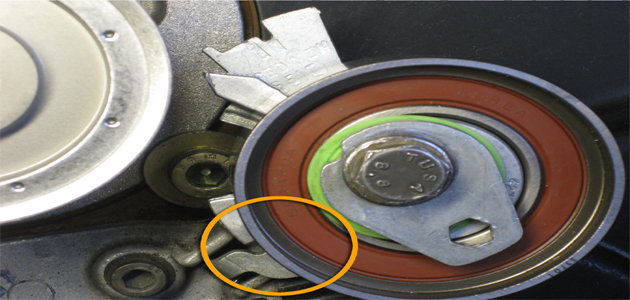
(Fig 6)
Position the new timing belt against the rotational direction, starting at the crankshaft gear. Turn the tension pulley with the adjusting cam to the left until the pointer is at the right stop. Here the hexagon socket screw moves anti-clockwise upwards; as before, use a hexagon socket wrench to do this. Then tighten the new tension pulley slightly (Fig 7 below).
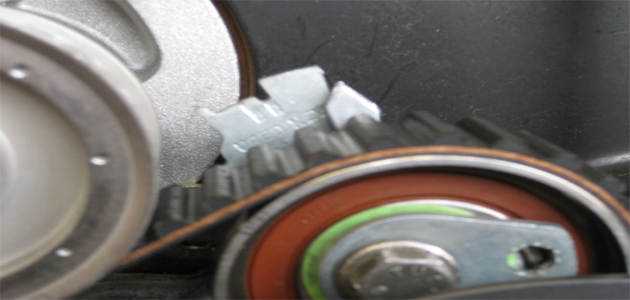
(Fig 7)
Note: This is an especially important step. If this is not done, the belt drive will start making noise in a short time due to insufficient tension.
Now rotate the engine by hand in the running direction at least twice after removing the locking tool. Loosen the tension pulley screw and turn the tension pulley to the right until the pointer is aligned with the notch in the bracket (Fig 8 below).
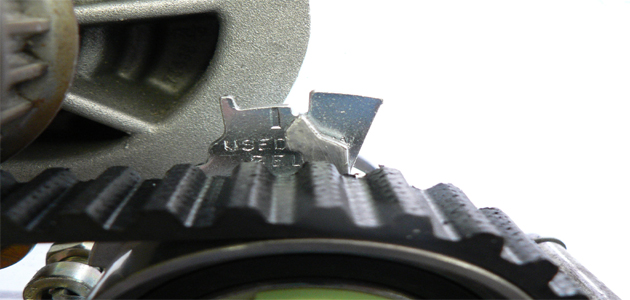
(Fig 8)
Tighten the tension pulley screw with a force of 20 Nm (Fig 9 below).
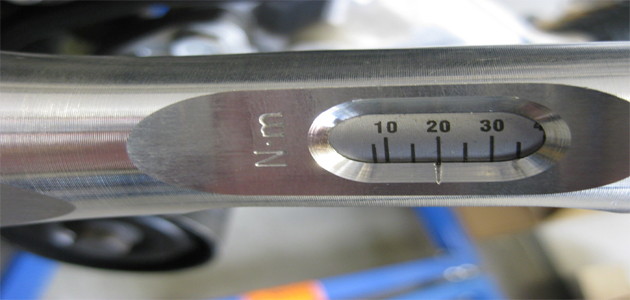
(Fig 9)
Turn the engine drive two more times, check the setting and adjust if necessary. Install the components in reverse order of removal. Fill up the cooling water and vent the cooling system. Record the replacement of the original ContiTech timing belt on the supplied sticker and affix it in the engine compartment (Fig 10 below).

(Fig 10)
Test run the engine or take the car for a test drive. Job done!









